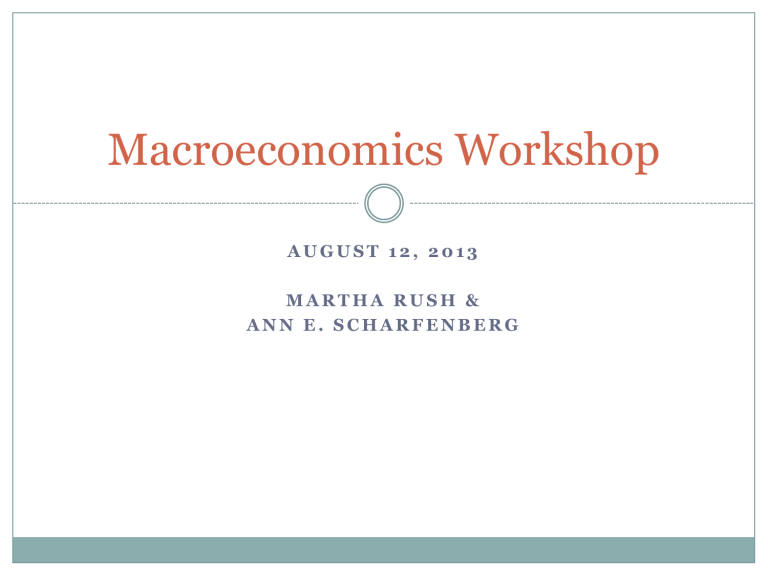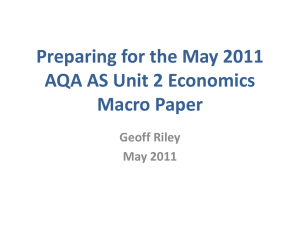Question - Mounds View School Websites

Macroeconomics Workshop
A U G U S T 1 2 , 2 0 1 3
M A R T H A R U S H &
A N N E . S C H A R F E N B E R G
Workshop Agenda
8:30-10:15 Intros; AP Macro outline, Basics
10:15-10:30 Break
10:30-11:45 AD/AS & Financial Sector
11:45-12:30 Lunch
12:30-1:15 Stabilization, Phillips Curve, Econ Growth
1:15-2:00 Open Econ, Trade, Balance of Payments
2:00-2:15 Break
2:15-3:00 AP Macro 2013 Free Response
3:00-4:00 Macroeconomic Resources
What did you sign up for…
Martha Rush
1997-today ~ Mounds View High School; AP Macro,
AP Micro, 9th grade Econ, AP Psych, Journalism
2007-2013 ~ AP Macro reader (Mac 2)
2012 ~ 3M Economic Educator of Excellence, Junior
Achievement Capstone Teacher
National Economics Challenge (2011, 2012, 2013)
Teacher Fellowships to Beijing (2005), St. Petersburg
(2006), South Africa (2010), & Germany (2013)
Ann E. Scharfenberg
1994-today ~ New Richmond High School; AP Micro,
AP Macro, Intro to Econ, K-12 Department Chair, SS
2006-2013 ~ AP Economics reader, table leader
2009 ~ WI SS High School Teacher of the Year
2006, 2008, 2010, 2012 ~ Traveled abroad with students
(Europe)
Teacher Fellowships to Russia (2007), Romania (2008),
Japan (2011), & Germany (2012)
Introduce yourself
Your Name & Current School
Econ classes for the upcoming school year.
What would you like to get out of this session?
One fun thing about you... OR
One summer adventure, favorite way to spend time
Macroeconomics
AP Macroeconomics
I.
II.
III.
IV.
V.
VI.
VII.
Basic Concepts (8-12%)
Measurement of
Economic Performance
(12-16%
AD and AS; SR & LR
(10-15%)
Financial Sector (10-
20%)
Stabilization Policies
(20-30%)
Economic Growth (5-
10%)
International Trade &
Finance (10-15%)
I. Basic Economic Concepts
Scarcity & choice
Opportunity cost
Trade-off
Production Possibilities
Graph
Comparative Advantage
Calculation of opportunity cost & terms of trade
Economic Systems
Circular flow
Scarcity & tradeoff
Increasing opportunity cost
Concave shape
Quantities not
Value or $
Assumptions
Fixed resources
Fixed technology
2 goods only
Economic
Growth
Graph #1
Production Possibilities Curve
(Frontier)
Microwaves & Cell Phones
Absolute Advantage
The ability to produce more units of a good or service than another, using the same quantity of resources
The ability to produce a good or service more efficiently, using fewer resources.
Comparative Advantage
David Ricardo ~ economic principle for trade
The ability to produce a good or service at a lower opportunity cost than another.
Specialization & Trade
Which country has the absolute advantage in cell phones?
Which country has the absolute advantage in microwaves?
What does this tell you?
Which country has the comparative advantage in producing cell phones?
Which country has the comparative advantage in producing microwaves?
What does this tell you?
Terms of Trade
1 2 3 4
Carrots
I. Basics continued
Demand ~ Consumers
Q d v. D
Supply ~ Producers
Q s v. S
Market for individual product determines price & quantity bought/sold graph
S
1
D
1
D
2
S
2
S
1
D
1
Understanding Economic Meaning…
II. Economic Performance
Business Cycle
Diagram
Circular Flow
Diagram
Intro to Indicators
GDP measurement
Counted or not
Income v. expenditures
Calculation; real & nominal
Unemployment
Types
Calculation; NRU; Okun’s law
Link to GDP
Inflation
CPI
GDP deflator
Build a Circular Flow Diagram
Visual of GDP
Circular Flow of Mixed Economy
III. National Income & Price Determination
What do students need to know about the Keynesian Cross?
Consumption is a function of income
MPC, MPS, & multiplier
MPC Disposable
Income
$12,000
$13,000
$14,000
$15,000
$16,000
$17,000
Consumption Saving
$12,100
$13,000
$13,800
$14,500
$15,100
$18,800
-$100
0
$200
$500
$900
$1400
--
MPS
--
Multipliers
Simple Spending Multiplier
1
MPS
Tax Multiplier
- MPC
MPS
Balanced Budget Multiplier
Equals 1
10:15 – 10:30
Graph #3
AD & AS
Graph #3
AD & AS
Aggregate demand (AD)
wealth effect real interest rate effect foreign purchases effect
Shifts in AD
C
Δ Income; Δ taxes or transfer payments ΔDI
I
Level of optimism; Interest rates
(inverse)
G
Discretionary G spending
X n
Foreign income
Consumer tastes
Δ Exchange rate
SR Aggregate supply (SRAS)
Upward sloping
Shifts
Input prices (cost of resources)
Tax policy
Regulation
LR Aggregate supply (LRAS)
Vertical
Shifts
Availability of resources)
Technology & productivity
Same as PPC
WAGE & RESOURCES PRICES
DO NOT SHIFT LRAS
LRAS & PPC (recessionary gap)
Vertical LR AS PPC
IV. Financial Sector
Graph #3
Money Market
Federal Reserve changes money supply
Reserve
Requirements
Discount rate
OMO
Buy bonds = bigger MS
Sell bonds = smaller MS
Bonds & interest rates
Graph #4
Loanable Funds
Banks & customers
S lf
~ savings, capital flows
D lf
~ private consumers & businesses
Crowding out
Foreign
Investment
11:45 – 12:30
V. Stabilization Policies
PL
The Perfect World
LRAS
SRAS
AD
Real GDP
PL
The Recession
LRAS
SRAS
AD1 AD
Real GDP
PL
AD Inflation
LRAS
SRAS
AD1
AD
Real GDP
PL
Stagflation
LRAS SRAS1
SRAS
AD
Real GDP
SR Phillips Curve illustrates trade-off between inflation & unemployment rate
Move along SR PC when AD shifts
Shift SR PC when expected inflation rate changes
Vertical LR PC @ natural rate of UE
Graph #5
Phillips Curve
VII. Open Economy
Graph #6 ~ Foreign Exchange Market
US Dollars Euros
S S
Q
USD
D
Q
Euros
D
Balance of Payments
Current Account
Exports and imports
Tourism
Net investment income
Net transfers
Financial Account
Purchases of real assets abroad (hotels, factories
Purchases of financial assets abroad (stocks, bonds)
Balance of Payments
Current account + financial account = 0
If it doesn’t, there is a change in government reserves
A foreign transaction counts as a “credit” for the U.S. if the USD is used (who gets paid?
A foreign transaction counts as a “debit” for the U.S. if a foreign currency is used (Who gets paid?)
2008 Q2 FRQ
Balance of payments accounts record all of a country’s international transactions during a year.
a) i) ii)
Two major subaccounts in the balance of payment are the current account and the capital financial account.
In which of these subaccounts will each of the following transaction be recorded?
a U.S. resident buys chocolate from Belgium a U.S. manufacturer buys computer equipment from Japan.
b) How would an increase in the real income in the U.S. affect the U.S. current account balance. Explain
2008 Q2 FRQ
Balance of payments accounts record all of a country’s international transactions during a year.
c) Using a correctly labeled graph of the foreign exchange market for the United States dollar, show how an increase in the United States firms’ direct investment in India will affect the value of the
United States dollar relative to the Indian rupee.
The AP Macroeconomics
Exam:Expectations
• Preliminary Rubric
• Expected Response
When answering the Macroeconomics or Microeconomics free response questions, a student should respond clearly and concisely. Including paragraphs or even full-sentence responses is not always necessary; however, it is important to address the verb prompts appropriately (see next slide).
A written response that presents conflicting answers is likely to lead to the loss of points.
46
The AP Macroeconomics Exam:
Expectations – Cont’d
Verb Prompts
“Show” means to use a diagram to illustrate your answer. Correct labeling of all elements including the axes of the diagram is necessary to receive full credit.
“Explain” means to take the reader through all of the steps or linkages in the line of economic reasoning. Graphs and symbols are acceptable as part of the explanation.
“Identify” means to provide a specific answer that might be a list or a label on a graph, without any explanation or elaboration.
“Calculate” means to use mathematical operations to determine a specific numerical response, along with providing your work.
47
Error Number 9
Question 1 (b)
Question: Assume that personal savings in the United States increase. Using a correctly labeled graph of the loanable funds
Market, show the impact of the increase in personal savings on the real interest rate.
Questions is worth two points: One point for proper labeling of graph and the S and D curves; one point for showing shift of S and change in real interest rate.
Error number 9 applies to the second point.
52
Real
Interest
Rate r
1 r
2
Error Number 9
Question 1 (b)
S
LF
S’
LF
53
D
LF
Quantity of
Loanable Funds
Error Number 1
Question 1 (c)(ii)
Question: (c) Based on the real interest rate change identified in part (b),
(i) will interest-sensitive expenditures increase, decrease, or remain unchanged?
(ii) what will happen to the rate of economic growth? Explain.
(From part (b), the real interest rate decreased.)
Increase because the capital stock increases.
54
Error Number 8
Question 1 (d)
Question: Assume that the real interest rate of the euro zone increases relative to the real interest rate of the United States.
Draw a correctly labeled graph of the foreign exchange market for the euro and show the impact of the change in the real interest rate in the euro zone on each of the following.
(i) Demand for the euro. Explain.
(ii) Value of the euro relative to the United States dollar
Question is worth three points: One point for proper labeling of graph and the S and D curves; one point for showing shift of D and change in value of euro; and one point for the “Explain.”
Error number 8 applies to the second point.
56
e=Dollars per euro e2 e1
Error Number 8
Question 1 (d)
S of euros
D’ for euros
D for euros
Quantity of euros
57
Error Number 3
Question 1(d)
Question: Assume that the real interest rate of the euro zone increases relative to the real interest rate of the United States.
Draw a correctly labeled graph of the foreign exchange market for the euro and show the impact of the change in the real interest rate in the euro zone on each of the following.
(i) Demand for the euro. Explain.
(ii) Value of the euro relative to the United States dollar
Question is worth three points: One point for proper labeling of graph and the S and D curves; one point for showing shift of D and change in value of euro; and one point for the “Explain.”
Error number 3 applies to the third point.
58
Error Number 3
Question 1(d)
The demand for the euro increases because investors buy euros in order to purchase financial assets with higher return in the eurozone.
59
Error Number 5
Question 1 (e)
Question: (e) Assume that the United States current account balance is zero. Based on the change in the value of the euro identified in part (d)(ii), will the United States current account balance now be in surplus, be in deficit, or remain at zero?
(In part (d)(ii), the euro appreciated, so the dollar depreciated.)
Surplus
60
Error Number 2
Question 2 (e)
Question: (e) Assume instead that no discretionary policy actions are taken. Will short-run aggregate supply increase, decrease,or remain the same in the long run? Explain.
(A recession had previously been assumed in the question.)
Increase because wages will fall in a recession.
(Alternatively, input prices and/or inflationary expectations fall.)
63
Error Number 4
Question 3 (b)
Question: (a) Draw a correctly labeled graph of a shortrun Phillips curve.
(b) Using your graph in part (a), show the effect of an increase in the expected rate of inflation.
Inflation
66
SRPC
SRPC’
Unemployment
Error Number 7
Question 3 (c)
Question: What is the effect of the increase in the expected rate of inflation on the long-run
Phillips curve?
No Change
67
Error Number 6
Question 3 (d) (ii)
Question: (d) Given the increase in the expected rate of inflation from part (b),
(i) will the nominal interest rate on new loans increase, decrease, or remain unchanged?
(ii) will the real interest rate on new loans increase, decrease, or remain unchanged?
Remain Unchanged
68
Error Number 10
Question 3, part (e)
Question: Assume that the nominal interest rate is 8 percent. Borrowers and lenders expect the rate of inflation to be 3 percent, and the growth rate of real gross domestic product is 4 percent. Calculate the real interest rate.
5 percent
69
Top Ten Errors on the
2013 AP Macro Exam
FRQ Question Averages
(Population)
Question 1: 4.88/10 (48.8%)
Question 2: 3.45/5 (68.9%)
Question 3: 2.85/6 (47.5%)
Range of Error Rates on Individual Points
(Sample of n≈1000)
54.04-89.4
70
2:00 – 2:15
Macro Resources
H T T P : / / A P C E N T R A L . C O L L E G E B O A R D . C O M / A P C / M E M B E R S /
E X A M / E X A M _ Q U E S T I O N S / 2 0 8 3 . H T M L
H T T P : / / W W W . C O U N C I L F O R E C O N E D . O R G / R E S O U R C E / A D V A
N C E D - P L A C E M E N T - E C O N O M I C S - 4 T H - E D I T I O N /
H T T P : / / W W W . R E F F O N O M I C S . C O M / T R B / I N P R O G R E S S / M A C
R O E C O N O M I C S
H T T P : / / W W W . Y O U T U B E . C O M / U S E R / A C D C L E A D E R S H I P
H T T P : / / W W W . A P L I A . C O M /
H T T P : / / W W W . Y O U T U B E . C O M / W A T C H ? V = D 0 N E R T F O - S K
H T T P : / / W W W . Y O U T U B E . C O M / W A T C H ? V = G T Q N A R Z M T O C
Extensions
E C O N O M I C S C H A L L E N G E
P E R S O N A L F I N A N C E D E C A T H L O N
F E D E R A L R E S E R V E E S S A Y C O N T E S T
G R E A T R E C E S S I O N L E S S O N
E C O N O M I C D E V E L O P M E N T P R O J E C T
Share take aways…
.
Provide an example of when or how
QUESTIONS?
Ann E. Scharfenberg
New Richmond High
School
715-243-1733 anns@newrichmond.k12
.wi.us
THANK YOU
Take time to enjoy the summer









